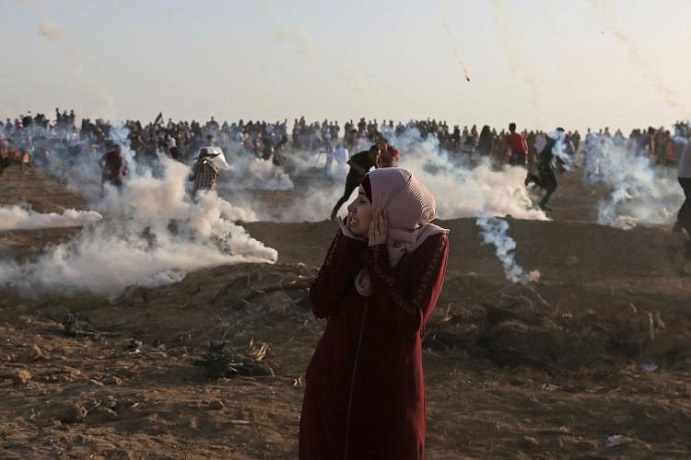Yesh Din / November 22, 2020
Beginning on March 30, 2018, Gaza residents took to the fence separating Gaza from Israel to stage mass protests. The Great March of Return (GMR), was held regularly every Friday, and sometimes on other days of the week as well, until the end of 2019.
The Israeli military responded to these protests with rules of engagement that allow soldiers to use potentially lethal force, including firing live rounds at protestors they identify as “primary instigators” or “primary rioters.” The military’s response to a petition filed by human rights organizations, including Yesh Din, against the rules of engagement for the Gaza protests indicated use of live fire against these primary “instigators” or “rioters” was permitted in certain conditions even if they did not pose a clear and immediate danger to human life. This policy showed unprecedented disregard for human life on Israel’s part and has resulted in the death and injury of protestors on a scale rarely seen even relative to the familiar standards of the Israeli occupation and the violent clashes it produces in the Occupied Territories.
While reports and complaints about Palestinian fatalities and injuries are normally reviewed by the Military Advocate General’s Corps (MAGC), which decides whether or not to launch criminal investigations, similar complaints regarding incidents that occurred during the Gaza protests are first reviewed by what the military calls the General Staff Mechanism for Fact-Finding Assessments, or the FFA Mechanism. The position paper titled ‘Killing Time’ analyses the work of the FFA Mechanism, based on data provided to Yesh Din by the Israeli military. Its main findings indicate:
- Foot dragging; The mechanism operates slowly: 231 incidents in which Palestinians were killed in protests have been forwarded to the FFA Mechanism. As of March 2020, two years after the GMR protests began, about 80% of the incidents are still under review of the FFA Mechanism or investigation by the military law enforcement system. The full significance of this figure comes into sharper focus when taking into account that the FFA Mechanism assessment is not the end of the investigation and enforcement process. The assessment is only the first, preliminary stage. The sluggishness of the FFA Mechanism means that if further investigations are later ordered into cases of protestor deaths, it is difficult to imagine how they could be serious, thorough and effective so long after the incident.
- A policy of non-investigation of injuries: The figures provided by the military indicate that the FFA Mechanism made inquiries only in complaints concerning incidents in which Palestinian protestors were killed. It failed to look into even a single case of the thousands of incidents of injuries, many of them severe, including cases of individuals who suffered gunshot wounds that left them permanently paralyzed and protestors who lost limbs. This fact is disturbing by its own right and raises questions about the fate of complaints regarding protestor injuries. The issue is particularly unsettling given that figures provided to Yesh Din regarding the military law enforcement system’s handling of soldiers suspected of harming Palestinians do not include reports of Palestinian injuries during the protests along the Gaza perimeter fence.
- One indictment and a lenient sentence following the killing of a protestor: Only one case has been concluded, and a soldier was indicted after a review of the investigative materials. The indictment was filed against a soldier for an incident in which Othman Rami Jawad Hillis, a 14-year-old boy from Gaza City, was shot and killed. According to the indictment, as Hillis approached the fence and began climbing it, the accused soldier fired at him without clearance from his commander and in defiance of the rules of engagement and the directives given to the soldiers. Hillis was pronounced dead on scene. The soldier was charged with a disciplinary offense as part of a plea bargain, and any reference to an offense related to the killing itself was removed. The soldier was convicted of abuse of authority to the point of endangering life or health and was sentenced to 30 days of military work, a suspended prison sentence and a demotion to the rank of private.
The sole indictment filed over the killing of a 14-year-old and the extremely lenient outcome of the legal proceedings resulting from his killing, given the overall data on the work of the FFA Mechanism and the law enforcement system, uncovers a string of flaws at every stage of the process: FFA Mechanism inquiries that are selective (injuries are never examined) and protracted (96 of 231 inquiries completed); slow decisions from the MAGC on whether to launch investigations (56 of the 96 incidents forwarded for a decision); a small number of criminal investigations opened (14 following FFA Mechanism inquiries and three more independently of it for a total of 17 investigations), which yielded only one indictment; and, at the end of the line – failure by the military prosecution to pursue an offense related to causing death and producing a conviction on a lesser, disciplinary charge.
The combination of permissive rules of engagement regarding firing at unarmed protestors and a law enforcement system that prevents genuine, effective investigation of protestor deaths is a lethal one. The result is the unfortunate, unnecessary loss of many lives, a lack of accountability for harming innocents and the abandonment of Gaza’s residents who remain defenceless against the specter of losing their lives.
See the full position paper:
https://s3-eu-west-1.amazonaws.com/files.yesh-din.org/KillingTime2020/Killing+Time_ENG.pdf













